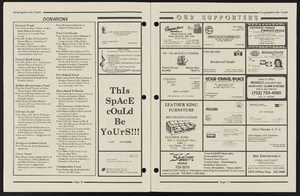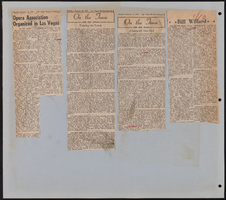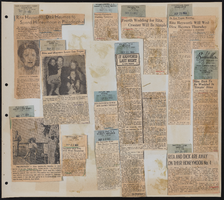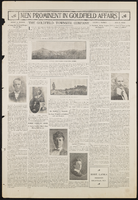Search the Special Collections and Archives Portal
Search Results
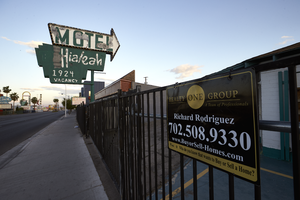
Photographs of Hialeah Motel sign, Las Vegas (Nev.), April 18, 2017
Date
Archival Collection
Description
Site address: 1924 Fremont St
Sign owner: La Jolla Development Group, LLC
Sign details: The current building was constructed in 1951 (Assessor). One source states that Tinkler's Motel may have been open on the site in the 1940's (VintageVegas.com, n.d.). A vintage postcard circa late 1940's-early 1950's advertises "Tinkler's Motel Hialeah", although the sign shown in the photograph states" Tinkler's Motel" (CardCow.com, n.d.). A vintage postcard circa 1950's-early 1960's shows the current name,"Hialeah Motel" (Las Vegas motels then and now, n.d.).
Sign condition: Condition is 3, fair. The cabinets are intact with no major rust damage. On the east side of the sign, the paint is flaking moderately on the upper arrow cabinet. On the west side, the paint is flaking severely on the upper arrow cabinet as well as the lower cabinet. Most of the incandescent light bulbs around the upper cabinet remain. All of the neon tubes are gone from both the lower and upper cabinets.
Sign form: Pole sign
Sign-specific description: The lower cabinet is shaped like three rectangles stacked upward in increasing size. The pole runs through the cabinet, which is cantilevered toward the street. The upper cabinet is shaped like an arrow pointed at the motel. The pole and lower cabinet are painted forest green. On the lower cabinet, hand painted sans serif letters state, "Hialeah 1924 VACANCY". The exterior of the upper arrow-shaped cabinet is painted black. The interior is white. The cabinet is channeled and holes for neon tubing are evident, but no neon remains. Yellow incandescent light bulbs outline the exterior of the cabinet. At the center of the pole on the hotel side is a horizontal pole from which a small sign may have hung previously.
Sign - type of display: Incandescent light bulbs, but the sign also had neon tubing at one time.
Sign - media: Steel
Sign - non-neon treatments: Incandescent light bulbs
Sign environment: This is located on East Fremont and has many other motels surrounding it though many of the neighboring motels are shut down.
Sign - date of installation: Possibly 1940's, likely circa 1950's-1960's
Sign - date of redesign/move: A vintage postcard circa late 1940's-early 1950's (CardCow.com, n.d.) shows a small sign which has either been replaced or modified over time. The sign consists of three cabinets mounted symmetrically on a pole. The lower cabinet is painted white and states, "AIR CONDITIONED" or "AIR CONDITIONER". The large central cabinet is black and states, "MOTEL". The smaller upper cabinet is painted black and advertises, "Tinkler's". A vintage postcard circa 1950's-early 1960's (Las Vegas motels then and now, n.d.). shows the current pole and cantilevered lower cabinet without the upper arrow-shaped cabinet. On the lower hotel side of the sign hangs a small yellow sign. Some or all of the lettering is traced with neon letters. By the late 1980's, the motel arrow had been added (VintageLasVegas.com, 2017). "MOTEL" is spelled out in red neon inside the channel of the arrow. The lower cabinet is painted green. "T.V." is spelled in black sans serif letters outlined in white. "Hialeah" is painted in white sans serif letters traced by clear neon letters. Below Hialeah is illegible clear neon, possibly "AIR CONDITIONING" or "AIR CONDITIONER". At the bottom of the lower cabinet "HAMBURGERS", "HOT DOGS" and "VACANCY" are spelled out in white san serif letters. A photograph taken sometime between the 1980's and 2008 (Jacobson, n.d.) shows the lettering on the lower cabinet simplified to the current design, except "T.V." is still painted to the left of "HIALEAH". Three yellow skeleton neon waves underline "T.V." and two more indistinguishable neon tubes of the same type sit over the "T". Some neon around "HIALEAH"in the lower cabinet and all of the neon around "MOTEL"in the upper arrow-shaped cabinet remain. By 2008, the sign had reached its current design (Las Vegas motels then and now, n.d.).
Sign - thematic influences: Horseracing (the motel name references Hialeah Park Racetrack in Hialeah, Florida; vintage postcard shows grass and racetrack type fencing [Las Vegas motels then and now, n.d.])
Sign - artistic significance: This location maintains the Horse Racing theme with their name. They also showcase 1940's (possibly), 1950's-1960's eras themes with emergence and prominence of the motor courts during those eras.
Survey - research locations: CardCow.com. (n.d.). Tinler's [sic] Motel Hialeah. Retrieved from https://www.cardcow.com/281785/tinlers-motel-hialeah-las-vegas-nevada/ Clark County Assessor, parcel no. 139-35-803-004. Retrieved from http://www.clarkcountynv.gov/assessor/Pages/PropertyRecords.aspx?H=redrock&P=assrrealprop/pcl.aspx Jacobson, J. (n.d.). Hialeah Motel [private image, copyright applies]. Retrieved from http://www.pbase.com/easystreet/image/103828763 Las Vegas motels then and now. (n.d.). 15: Hialeah Motel. Retrieved from http://stefanidrivesvegas.com/2.html VintageLasVegas.com. (n.d.). Downtown Las Vegas hotels & casinos 1931-2000. Retrieved from http://vintagelasvegas.com/downtown VintageLasVegas.com. (2017 February 2). Hialeah Motel. Retrieved from http://vintagelasvegas.com/tagged/Hialeah-Motel
Surveyor: Mitchell Cohen
Survey - date completed: 2017-08-23
Sign keywords: Neon; Incandescent; Steel; Pole sign; Directional
Mixed Content
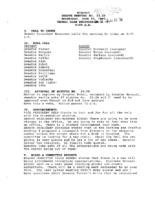
Meeting minutes for Consolidated Student Senate University of Nevada, Las Vegas, June 16, 1993
Date
Archival Collection
Description
Text
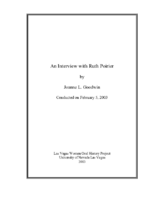
Transcript of interview with Ruth Poirier by Joanne Goodwin, February 5, 2003
Date
Archival Collection
Description
In 1927, a sixteen-year-old girl from Rockford, Illinois moved to New York City to play trumpet with the all-girl bands common from the 1920s through the end of World War II. During this period, which spanned Prohibition, the Great Depression, and World War II, all-girl bands came into their own in America. They were especially popular during the war, when most men were off fighting but people still needed and appreciated music. This was also a time when jazz and swing became wildly popular in this country. All-girl bands were able fill a niche left empty by men at war. Doris Eloise Pressler was born in Jamesville, Illinois on January 17, 1911 to Bertha Hendrich Pressler and Louis Pressler. Almost immediately after her birth, the Pressler family moved to Rockford, Illinois. Bertha was a teacher, a homemaker and mother. Louis did auto body hand-painting and also managed a bar. In addition, he played baritone saxophone and taught his daughter Doris to play trumpet. They both performed with hometown bands, playing churches, dances, and other social events. In 1927 at age sixteen, Doris left school, moved out of the family home, and went to work for Walgreens in downtown Rockford. In her free time she played music. Doris began her professional music career in 1927 as a trumpeter with the Gypsy Sweethearts in Rockford. That same year, she moved to New York, where she played in the only women’s band that ever performed at New York’s historic Roseland Ballroom. During the early 1930s, Doris performed with the Red Dominos, an all-girl band that was part of a variety show produced by E. K. Nadel. However, it was tough for girl musicians during the Depression. Few managers wanted to hire female players when so many men were out of work. Doris persevered, and through the 1940s, she traveled and played with other all-girl bands such as Annette Demon and her French Dolls and the Hollywood Debs. While Doris pursued her music career, a little girl in Wisconsin was learning to play the piano and trombone. Born on April 13, 1917, Ruth Poirier came from a musical family: her father John played drums and French horn, her brother drums and bassoon. John performed with the local Elks Club group, while Ruth and her brother played for their high school band. Ruth’s mother Mary had been a nurse, so when she finished high school Ruth decided to attend nursing school in Chicago. After a year, she returned home to Wisconsin and trained as a beautician. In 1939, Ruth answered a local ad for girl musicians and signed on as a trombonist with an all-girl band. Her first gig lasted only a month, the band dissolved, and she left to tour with Annette Demon and her French Dolls out of Milwaukee. While playing down South, Ruth met a fellow musician who became her lifelong companion, Doris Pressler. In July 1939, Ruth and Doris took off for Southern California. While living in Long Beach, Doris performed with bands at the 660 Club on the Pike, a well-known waterfront amusement park, and at the Waldorf Cellar. She also played a gig at Murphy’s, across from the Showboat in Las Vegas. Girl musicians began getting more jobs because the men were being called into military service. Ruth, a “Rosie the Riveter” during the war years, helped to build Navy fighter planes for Douglas Aircraft in El Segundo, California. After the war ended in 1945 women, whether “Rosie the Riveters” or band members, lost their jobs to the hordes of returning servicemen. Realizing that all-girl bands were “gonna go nowhere at all,” Doris had decided in the early 1940s to return to school and pursue studies in her second love, mathematics. She took classes in math and engineering at the University of Southern California, and then joined the Los Angeles County surveyors’ department as a civil engineer. After two years there, Doris transferred to the road department, where she worked until her retirement in 1974. Ruth returned to work as a beautician, running a shop out of her home. The Greater Los Angeles area contained an active gay and lesbian community both during and after the war. Doris and Ruth enjoyed a social life that included girls’ clubs such as Tess’s and drag clubs like the Flamingo. According to Ruth, these were “sitting-down, drinking places…and visiting. We had one club where they had dancing…. But then they let everybody in.” After the war, everybody just wanted to have fun, and Doris and Ruth enjoyed getting together with all types of friends in clubs and in private homes. During these at-home evenings, Doris and others would play popular music for everyone’s enjoyment. After their retirement to Las Vegas in 1974, Doris and Ruth were active in their local senior center. Doris played with the Las Vegas Senior Band for ten years, and Ruth worked in support of the band and the center. According to Ruth, Doris loved playing with the band, and enjoyed it more because she was retired and could devote herself to her playing. Doris Pressler and Ruth Poirier lived together through six decades of radical social change in America. From the rise of women musicians and workers outside the home, through the return of women to more “traditional” roles after World War II, and finally the revolution in women’s roles from the 1960s to the present, Doris and Ruth experienced it all. And through it all, they maintained a relationship that lasted for 62 years, until Doris’s death. According to Ruth, “I enjoyed my life. I never found anything wrong with . ... I think Doris would say the same."
Text

Herman Jimerson, Ruth Jimerson-Carter, and Leon Carter Jr. oral history interview: transcript
Date
Archival Collection
Description
Herman Jimerson and his younger sister Ruth Jimerson-Carter, along with her husband Leon Carter Jr., gathered on March 3, 2021, to talk about their memories and experiences growing up in West Las Vegas—the Westside.
OH-03746 contains additional interviews with the Carter family that are not transcribed in this document. Contact special.collections@unlv.edu for more information.
Text

Andrea Gardea oral history interview: transcript
Date
Archival Collection
Description
Oral history interview with Andrea Gardea conducted by Barbara Tabach on June 26, 2019 for the Remembering 1 October Oral History Project. Gardea starts talking about her early life, family, and family history. She explains why she moved to Las Vegas, Nevada in 2002 and why she chose to attend University of Nevada, Las Vegas. After, Gardea describes what happened before and during the Route 91 Harvest festival, what she experienced during the shooting, and her journey in escaping the scene. She talks about the aftermath of the shooting, the trauma and PTSD experienced, and her healing process. Gardea also talks about the making of Engelland’s Vegas Born Heroes Foundation in 2018, what they do, and what they represent. Lastly, she talks about her opinions on gun control and her viewpoint on making peace.
Text

Yvanna Cancela oral history interview: transcript
Date
Archival Collection
Description
Oral history interview with Yvanna Cancela conducted by Monserrath Hernández and Barbara Tabach on February 27, 2020 for the Latinx Voices of Southern Nevada Oral History Project. Yvanna Cancela, Nevada State Senator, discusses her personal history growing up in Miami, Florida and her studies at Northwestern University. She talks of working for Senator Harry Reid's campaign in Las Vegas, which led to her organizing efforts for the Culinary Workers Union Local 226. Yvanna recalls being appointed to the Nevada State Senate in 2016 as the first female state senate majority. In addition to fulfilling her duties as the Co-Majority Whip, she worked on the Joe Biden campaign and is the Executive Director of the Citizenship Project. After this interview was conducted, Yvanna received her Juris Doctorate from the William S. Boyd School of Law at the University of Nevada, Las Vegas. Subjects discussed include: Miami, Florida; Nevada State Senate; The Citizenship Project.
Text

